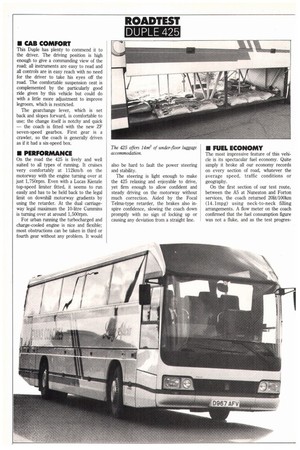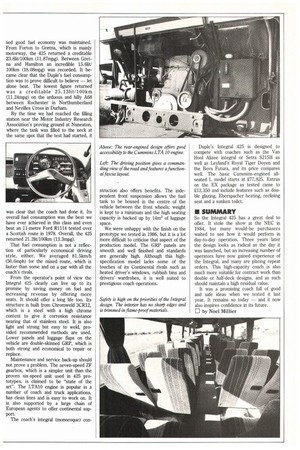ROADTEST DUPLE 425
Page 78

Page 79

If you've noticed an error in this article please click here to report it so we can fix it.
• CAB COMFORT
This Duple has plenty to commend it to the driver. The driving position is high enough to give a commanding view of the road; all instruments are easy to read and all controls are in easy reach with no need for the driver to take his eyes off the road. The comfortable suspension seat is complemented by the particularly good ride given by this vehicle but could do with a little more adjustment to improve legroom, which is restricted.
The gearchange lever, which is set back and slopes forward, is comfortable to use; the change itself is notchy and quick — the coach is fittedwith the new ZF seven-speed gearbox. First gear is a crawler, so the coach is generally driven as if it had a six-speed box.
• PERFORMANCE
On the road the 425 is lively and well suited to all types of running. It cruises very comfortably at 112km/h on the motorway with the engine turning over at just 1,750rpm. Even with a Lucas Kienzle top-speed limiter fitted, it seems to run easily and has to be held back to the legal limit on downhill motorway gradients by using the retarder. At the dual carriageway legal maximum the 10-litre Currunins is turning over at around 1,500rpm.
For urban running the turbocharged and charge-cooled engine is nice and flexible; most obstructions can be taken in third or fourth gear without any problem. It would also be hard to fault the power steering and stability.
The steering is light enough to make the 425 relaxing and enjoyable to drive, yet firm enough to allow confident and steady driving on the motorway without much correction. Aided by the Focal Telma-type retarder, the brakes also inspire confidence, slowing the coach down promptly with no sign of locking up or causing any deviation from a straight line.
• FUEL ECONOMY
The most impressive feature of this vehicle is its spectacular fuel economy. Quite simply it broke all our economy records on every section of road, whatever the average speed, traffic conditions or geography.
On the first section of our test route, between the A5 at Nuneaton and Forton services, the coach returned 20lit/100km (14.1mpg) using neck-to-neck filling arrangements. A flow meter on the coach confirmed that the fuel consumption figure was not a fluke, and as the test progres sed good fuel economy was maintained. From Forton to Gretna, which is mainly motorway, the 425 returned a creditable 23.8lit/100km (11.87mpg). Between Gretna and Hamilton an incredible 15.61it/ 100km (18.08mpg) was recorded. It became clear that the Duple's fuel consumption was to prove difficult to believe — let alone beat. The lowest figure returned was a creditable 2 5.131it/100km (11.24mpg) on the arduous and hilly A68 between Rochester in Northumberland and Nevilles Cross in Durham.
By the time we had reached the filling station near the Motor Industry Research Association's proving ground at Nuneaton, where the tank was filled to the neck at the same spot that the test had started, it was clear that the coach had done it. Its overall fuel consumption was the best we have ever achieved in this class and even beat an 11-metre Ford R1114 tested over a Scottish route in 1978. Overall, the 425 returned 21.21it/100km (13.3mpg).
That fuel consumption is not a reflection of particularly economical driving style, either. We averaged 81.5km/h (50.6mph) for the mixed route, which is faster than some and on a par with all the coach's rivals.
From the operator's point of view the Integral 425 dearly can live up to its promise by saving money on fuel and increasing revenue by offering more seats. It should offer a long life too. Its structure is built from Chromweld 3CR12, which is a steel with a high chrome content to give it corrosion resistance nearing that of stainless steel. It is also light and strong but easy to weld, provided recommended methods are used. Lower panels and luggage flaps on the vehicle are double-skinned GRP, which is both strong and economical to repair or replace.
Maintenance and service back-up should not prove a problem. The seven-speed ZF gearbox, which is a simpler unit than the proven six-speed unit used in 425 prototypes, is claimed to be "state of the art". The LTA10 engine is popular in a number of coach and truck applications, has clean lines and fS easy to work on. It is also supported by a large chain of European agents to offer continental support
The coach's integral (monocoque) con
struction also offers benefits. The independent front suspension allows the fuel tank to be housed in the centre of the vehicle between the front wheels; weight is kept to a minimum and the .high seating capacity is backed up by 14m3 of luggage space.
We were unhappy with the finish on the prototype we tested in 1986, but it is a lot more difficult to criticise that aspect of the production model. The GRP panels are smooth and well finished and standards are generally high. Although this highspecification model lacks some of the touches of its Continental rivals such as heated driver's windows, rubbish bins and drivers' wardrobes, it is well suited to prestigious coach operations. Duple's Integral 425 is designed to compete with coaches such as the Van Hool Alizee integral or Setra S21511 as well as Leyland's Royal Tiger Doyen and the Bova Futura, and its price compares well. The basic Cummins-engined allseated L model starts at .V7,825. Extras on the EX package as tested came to ,E12,350 and include features such as double glazing, Eberspacher heating, reclining seat and a sunken toilet.
• SUMMARY
So the Integral 425 has a great deal to offer. It stole the show at the NEC in 1984, but many would-be purchasers waited to see how it would perform in day-to-day operation. Three years later the design looks as radical as the day it was launched, but an increasing number of operators have now gained experience of the Integral, and many are placing repeat orders. This high-capacity coach is also much more suitable for contract work than double or half-deck designs, and as such should maintain a high residual value.
It was a promising coach full of good and safe ideas when we tested it last
year. It remains so today and it now also inspires confidence in its future. by Noel Millier












































































































































































